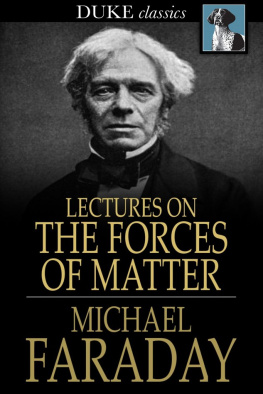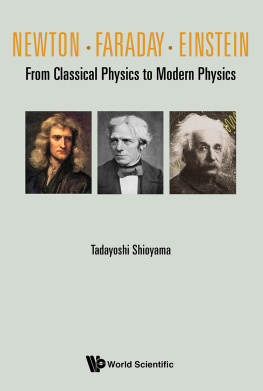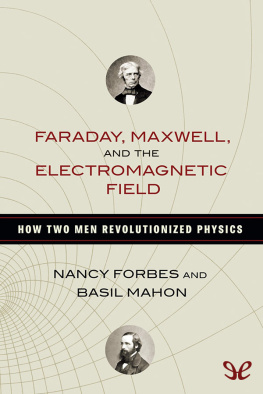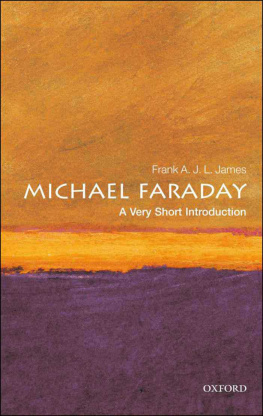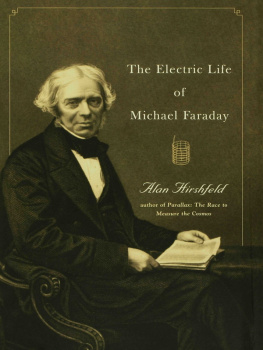Faraday - The Chemical History of a Candle
Here you can read online Faraday - The Chemical History of a Candle full text of the book (entire story) in english for free. Download pdf and epub, get meaning, cover and reviews about this ebook. City: Luton;Bedfordshire, year: 2012, publisher: Andrews UK, genre: Art. Description of the work, (preface) as well as reviews are available. Best literature library LitArk.com created for fans of good reading and offers a wide selection of genres:
Romance novel
Science fiction
Adventure
Detective
Science
History
Home and family
Prose
Art
Politics
Computer
Non-fiction
Religion
Business
Children
Humor
Choose a favorite category and find really read worthwhile books. Enjoy immersion in the world of imagination, feel the emotions of the characters or learn something new for yourself, make an fascinating discovery.

The Chemical History of a Candle: summary, description and annotation
We offer to read an annotation, description, summary or preface (depends on what the author of the book "The Chemical History of a Candle" wrote himself). If you haven't found the necessary information about the book — write in the comments, we will try to find it.
The Chemical History of a Candle — read online for free the complete book (whole text) full work
Below is the text of the book, divided by pages. System saving the place of the last page read, allows you to conveniently read the book "The Chemical History of a Candle" online for free, without having to search again every time where you left off. Put a bookmark, and you can go to the page where you finished reading at any time.
Font size:
Interval:
Bookmark:
THE CHEMICAL HISTORY OF A CANDLE
A COURSE OF LECTURES DELIVERED BEFORE A JUVENILE AUDIENCE AT THE ROYAL INSTITUTION
BY
MICHAEL FARADAY, D.C.L., F.R.S.
EDITED BY
WILLIAM CROOKES, F.C.S.
This edited version, including layout, typography, additions to text, cover artwork and other unique factors is copyright 2012 Andrews UK Limited
This book is sold subject to the condition that it shall not, by way of trade or otherwise, be lent, resold, hired out or otherwise circulated without the publishers prior written consent in any form of binding or cover other than that in which it is published, and without a similar condition being imposed on the subsequent purchaser.
PREFACE
From the primitive pine-torch to the paraffin candle, how wide an interval! between them how vast a contrast! The means adopted by man to illuminate his home at night, stamp at once his position in the scale of civilisation. The fluid bitumen of the far East, blazing in rude vessels of baked earth; the Etruscan lamp, exquisite in form, yet ill adapted to its office; the whale, seal, or bear fat, filling the hut of the Esquimaux or Lap with odour rather than light; the huge wax candle on the glittering altar, the range of gas lamps in our streets, - all have their stories to tell. All, if they could speak (and, after their own manner, they can), might warm our hearts in telling, how they have ministered to man's comfort, love of home, toil, and devotion.
Surely, among the millions of fire-worshippers and fire-users who have passed away in earlier ages, some have pondered over the mystery of fire; perhaps some clear minds have guessed shrewdly near the truth. Think of the time man has lived in hopeless ignorance: think that only during a period which might be spanned by the life of one man, has the truth been known.
Atom by atom, link by link, has the reasoning chain been forged. Some links, too quickly and too slightly made, have given way, and been replaced by better work; but now the great phenomena are known - the outline is correctly and firmly drawn - cunning artists are filling in the rest, and the child who masters these Lectures knows more of fire than Aristotle did.
The candle itself is now made to light up the dark places of nature; the blowpipe and the prism are adding to our knowledge of the earth's crust; but the torch must come first.
Among the readers of this book some few may devote themselves to increasing the stores of knowledge: the Lamp of Science must burn. "Alere flammam."
W. CROOKES.
LECTURE I.
A CANDLE: THE FLAME - ITS SOURCES - STRUCTURE - MOBILITY - BRIGHTNESS.
I purpose, in return for the honour you do us by coming to see what are our proceedings here, to bring before you, in the course of these lectures, the Chemical History of a Candle. I have taken this subject on a former occasion; and were it left to my own will, I should prefer to repeat it almost every year - so abundant is the interest that attaches itself to the subject, so wonderful are the varieties of outlet which it offers into the various departments of philosophy. There is not a law under which any part of this universe is governed which does not come into play, and is touched upon in these phenomena. There is no better, there is no more open door by which you can enter into the study of natural philosophy, than by considering the physical phenomena of a candle. I trust, therefore, I shall not disappoint you in choosing this for my subject rather than any newer topic, which could not be better, were it even so good.
And before proceeding, let me say this also - that though our subject be so great, and our intention that of treating it honestly, seriously, and philosophically, yet I mean to pass away from all those who are seniors amongst us. I claim the privilege of speaking to juveniles as a juvenile myself. I have done so on former occasions - and, if you please, I shall do so again. And though I stand here with the knowledge of having the words I utter given to the world, yet that shall not deter me from speaking in the same familiar way to those whom I esteem nearest to me on this occasion.
And now, my boys and girls, I must first tell you of what candles are made. Some are great curiosities. I have here some bits of timber, branches of trees particularly famous for their burning. And here you see a piece of that very curious substance taken out of some of the bogs in Ireland, called candle-wood, - a hard, strong, excellent wood, evidently fitted for good work as a resister of force, and yet withal burning so well that where it is found they make splinters of it, and torches, since it burns like a candle, and gives a very good light indeed. And in this wood we have one of the most beautiful illustrations of the general nature of a candle that I can possibly give. The fuel provided, the means of bringing that fuel to the place of chemical action, the regular and gradual supply of air to that place of action - heat and light - all produced by a little piece of wood of this kind, forming, in fact, a natural candle.
But we must speak of candles as they are in commerce. Here are a couple of candles commonly called dips. They are made of lengths of cotton cut off, hung up by a loop, dipped into melted tallow, taken out again and cooled, then re-dipped until there is an accumulation of tallow round the cotton. In order that you may have an idea of the various characters of these candles, you see these which I hold in my hand - they are very small, and very curious. They are, or were, the candles used by the miners in coal mines. In olden times the miner had to find his own candles; and it was supposed that a small candle would not so soon set fire to the fire-damp in the coal mines as a large one; and for that reason, as well as for economy's sake, he had candles made of this sort - 20, 30, 40, or 60 to the pound. They have been replaced since then by the steel-mill, and then by the Davy-lamp, and other safety-lamps of various kinds. I have here a candle that was taken out of the Royal George[1], it is said, by Colonel Pasley. It has been sunk in the sea for many years, subject to the action of salt water. It shews you how well candles may be preserved; for though it is cracked about and broken a good deal, yet, when lighted, it goes on burning regularly, and the tallow resumes its natural condition as soon as it is fused.
Mr. Field, of Lambeth, has supplied me abundantly with beautiful illustrations of the candle and its materials. I shall therefore now refer to them. And, first, there is the suet - the fat of the ox - Russian tallow, I believe, employed in the manufacture of these dips, which Gay Lussac, or some one who entrusted him with his knowledge, converted into that beautiful substance, stearin, which you see lying beside it. A candle, you know, is not now a greasy thing like an ordinary tallow candle, but a clean thing, and you may almost scrape off and pulverise the drops which fall from it without soiling anything. This is the process he adopted[2]: - The fat or tallow is first boiled with quick-lime, and made into a soap, and then the soap is decomposed by sulphuric acid, which takes away the lime, and leaves the fat re-arranged as stearic acid, whilst a quantity of glycerin is produced at the same time. Glycerin - absolutely a sugar, or a substance similar to sugar - comes out of the tallow in this chemical change. The oil is then pressed out of it; and you see here this series of pressed cakes, shewing how beautifully the impurities are carried out by the oily part as the pressure goes on increasing, and at last you have left that substance which is melted, and cast into candles as here represented. The candle I have in my hand is a stearin candle, made of stearin from tallow in the way I have told you. Then here is a sperm candle, which comes from the purified oil of the spermaceti whale. Here also are yellow bees-wax and refined bees-wax, from which candles are made. Here, too, is that curious substance called paraffin, and some paraffin candles made of paraffin obtained from the bogs of Ireland. I have here also a substance brought from Japan, since we have forced an entrance into that out-of-the-way place - a sort of wax which a kind friend has sent me, and which forms a new material for the manufacture of candles.
Next pageFont size:
Interval:
Bookmark:
Similar books «The Chemical History of a Candle»
Look at similar books to The Chemical History of a Candle. We have selected literature similar in name and meaning in the hope of providing readers with more options to find new, interesting, not yet read works.
Discussion, reviews of the book The Chemical History of a Candle and just readers' own opinions. Leave your comments, write what you think about the work, its meaning or the main characters. Specify what exactly you liked and what you didn't like, and why you think so.

